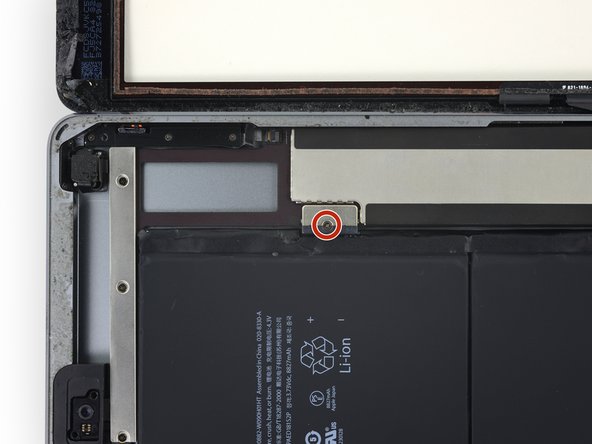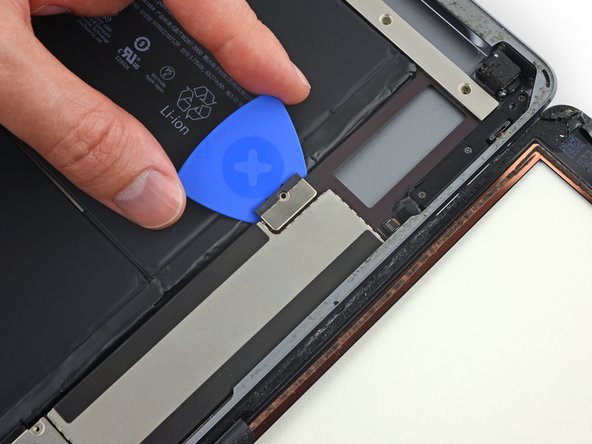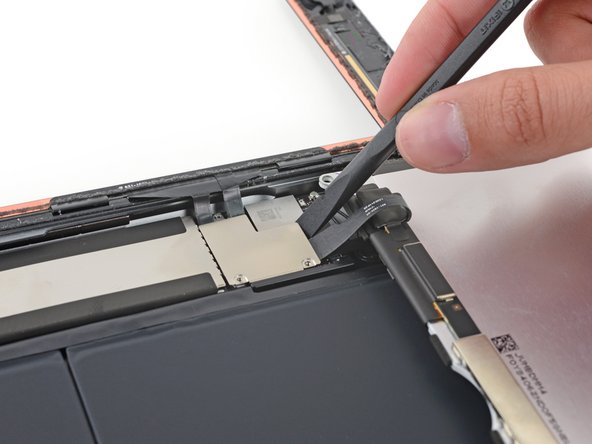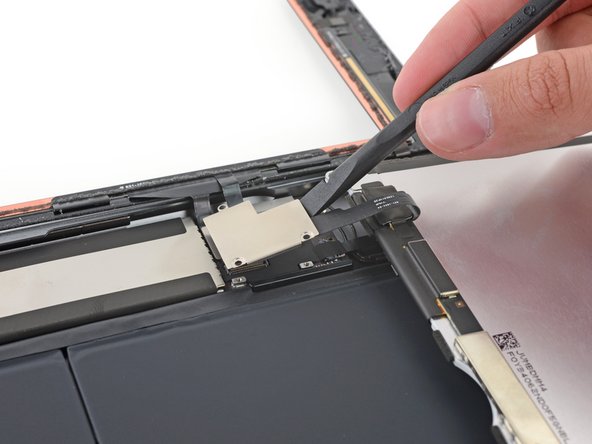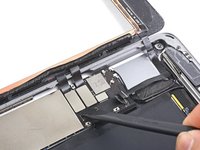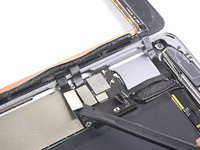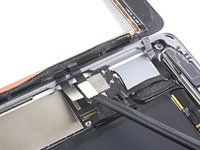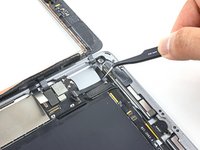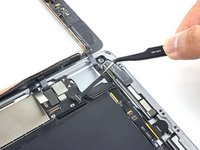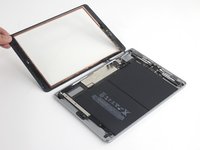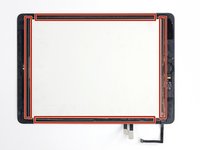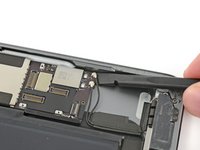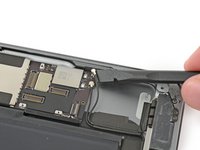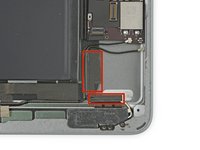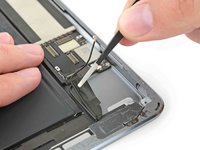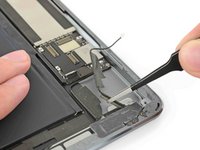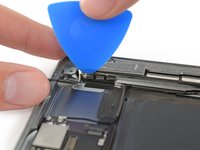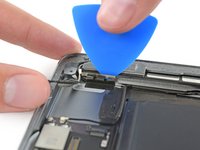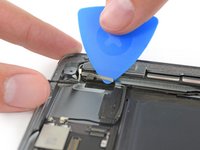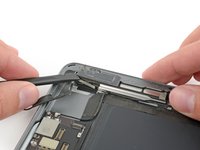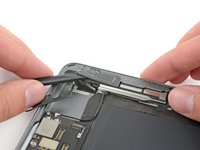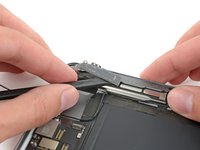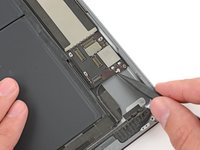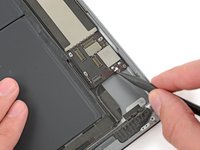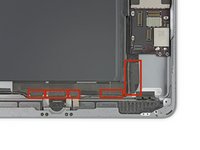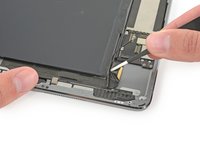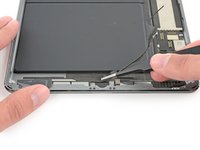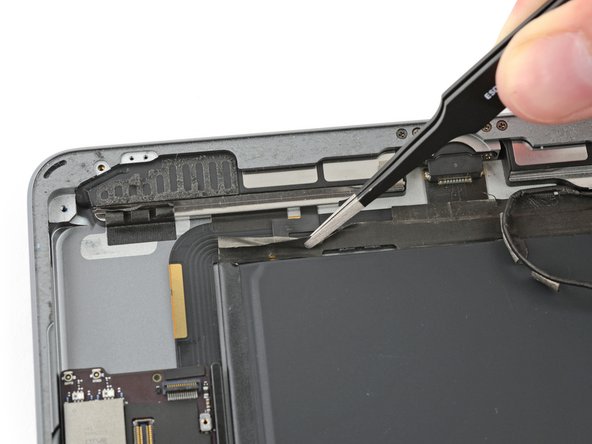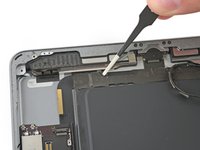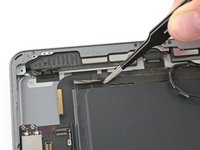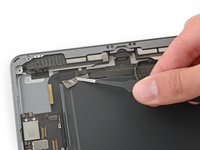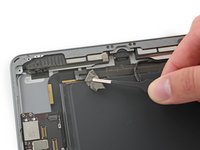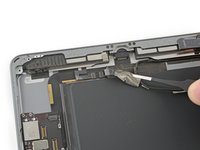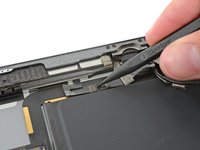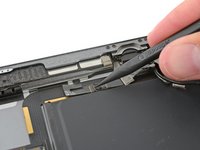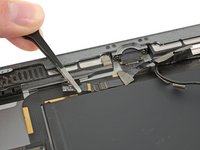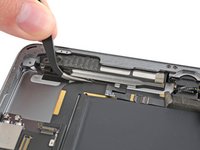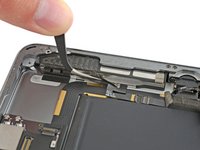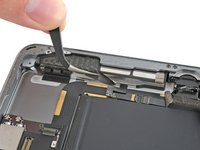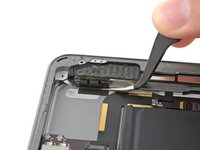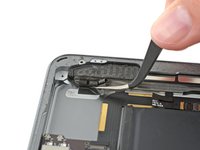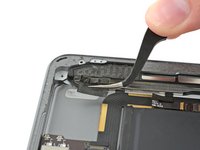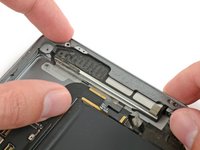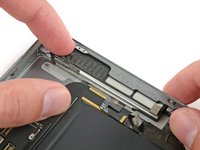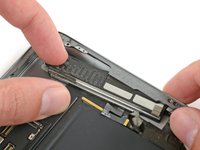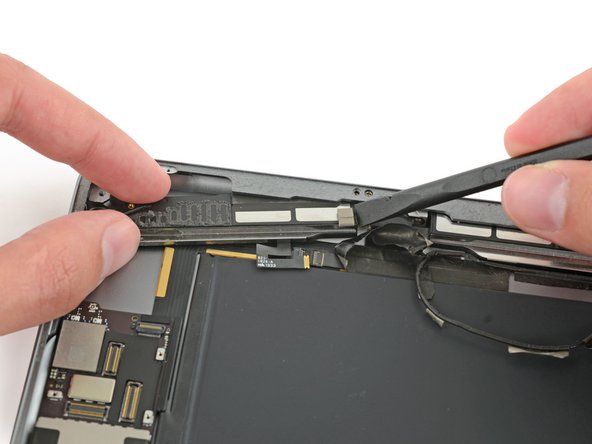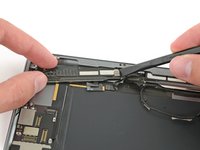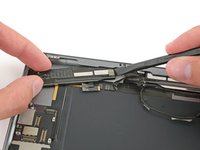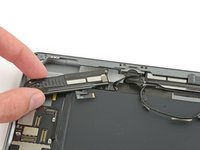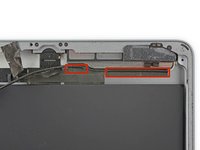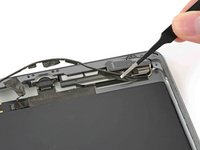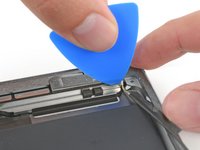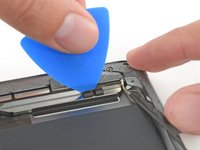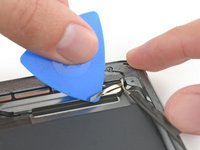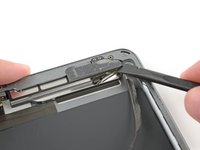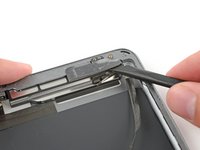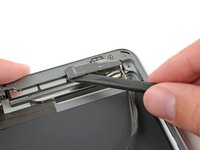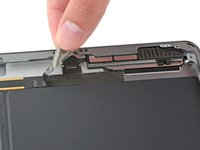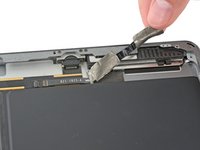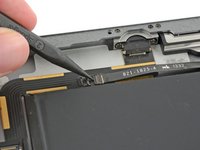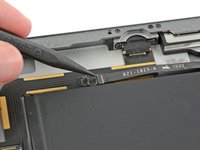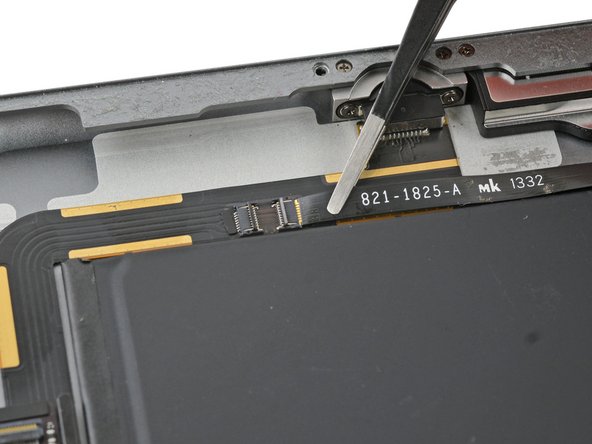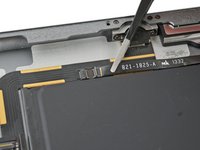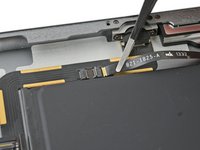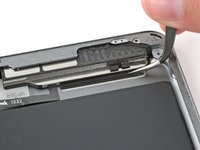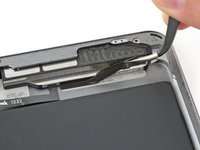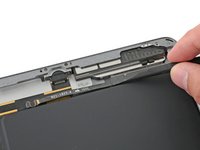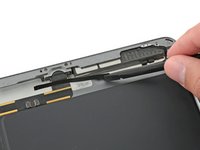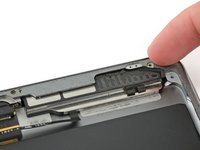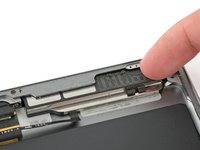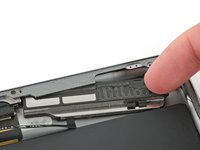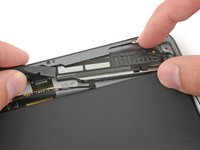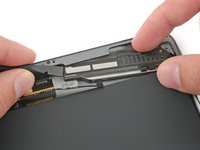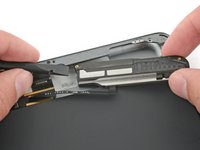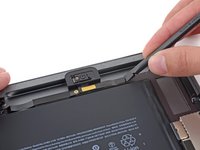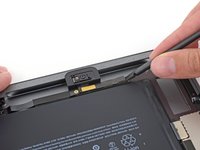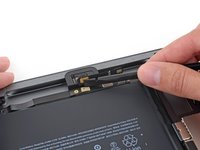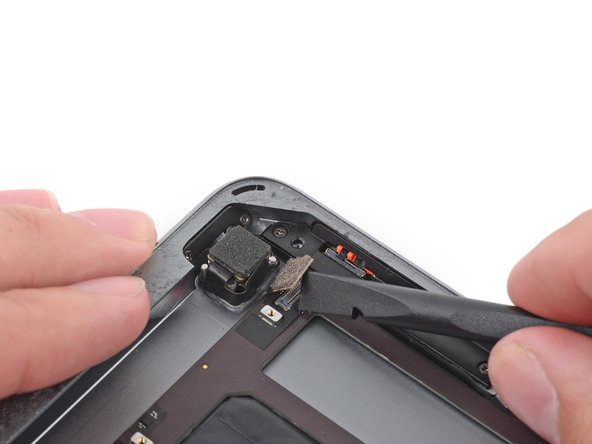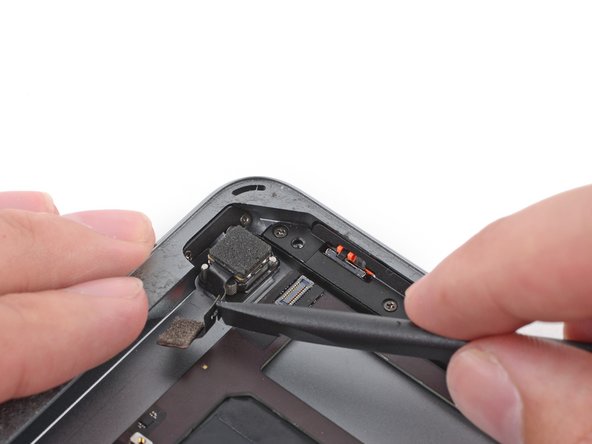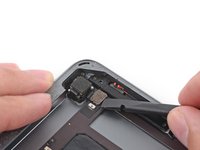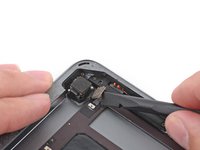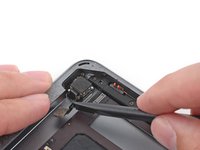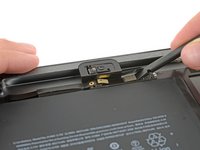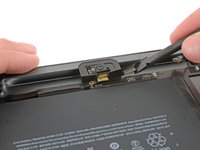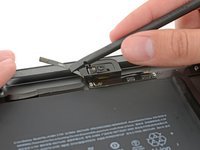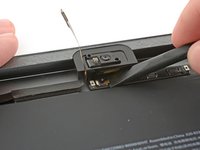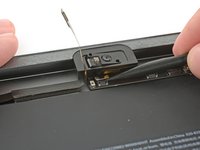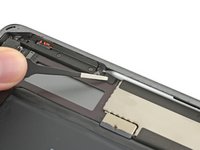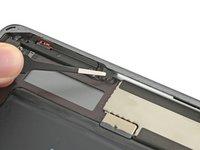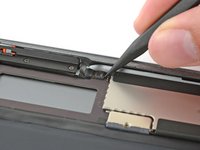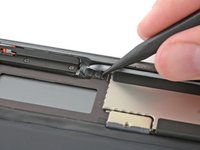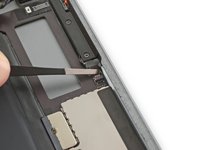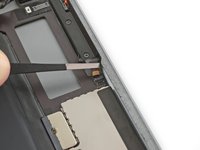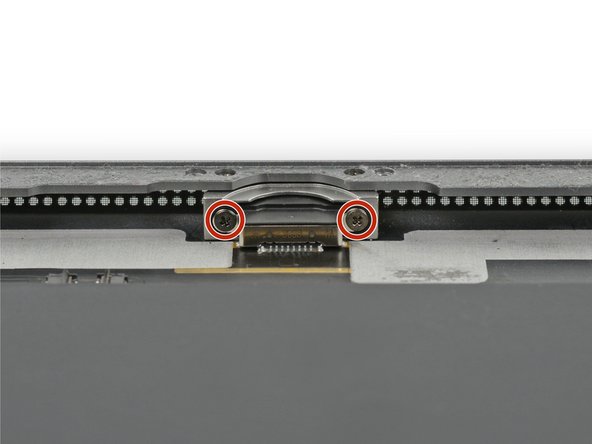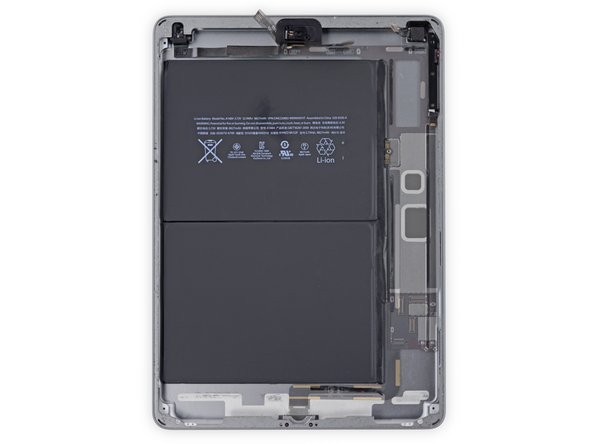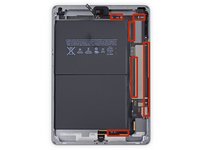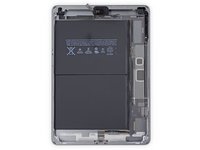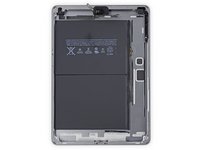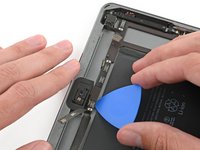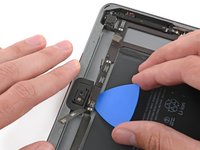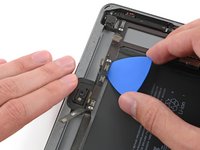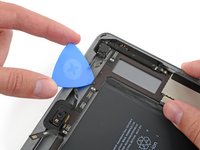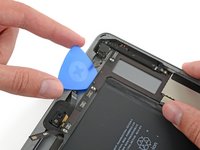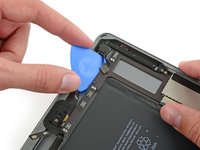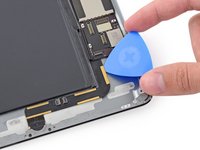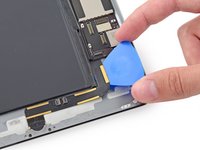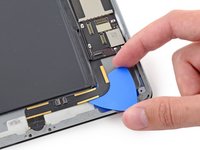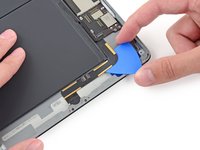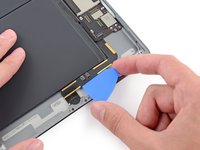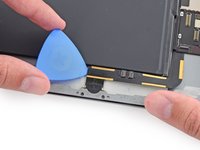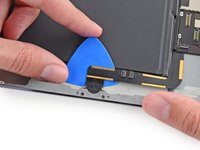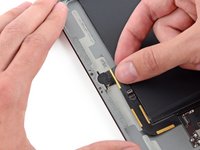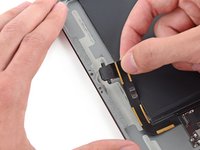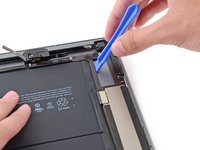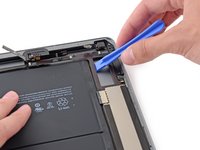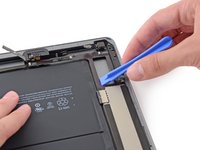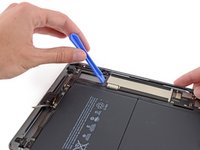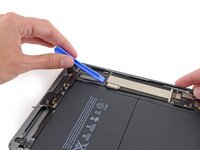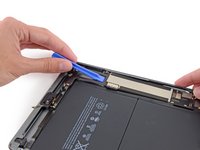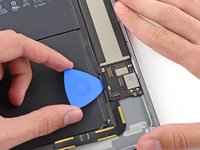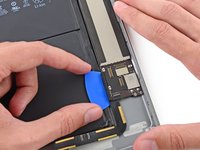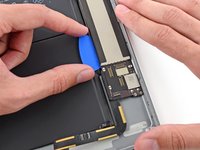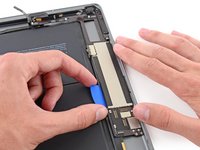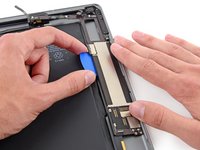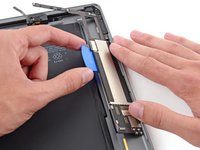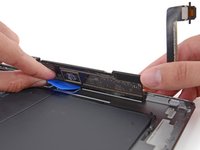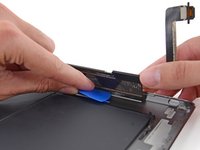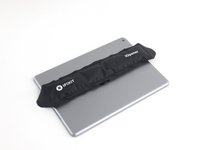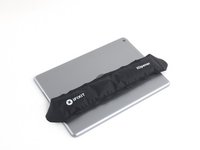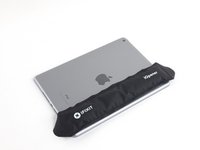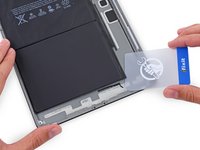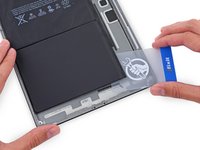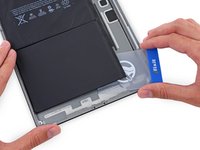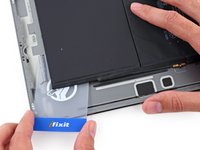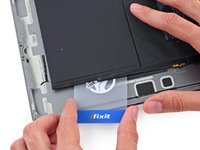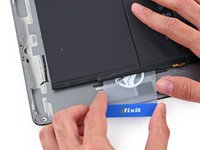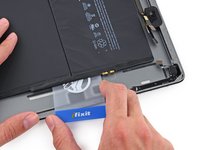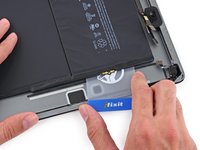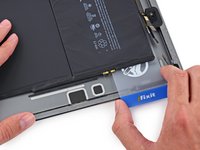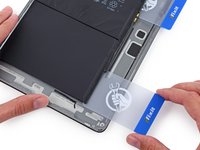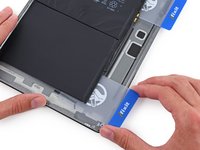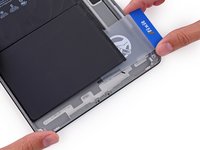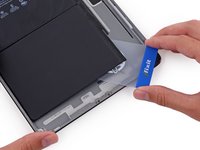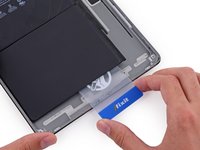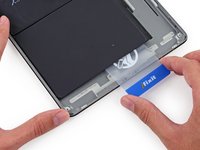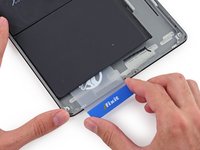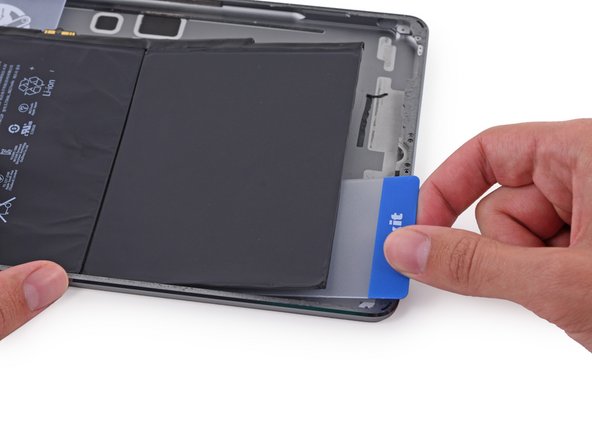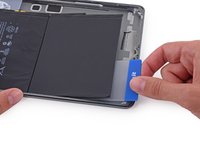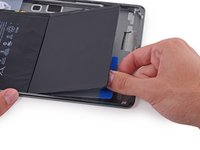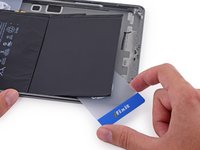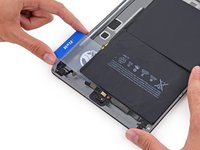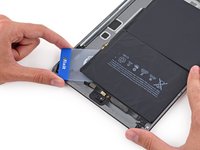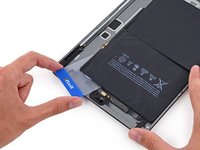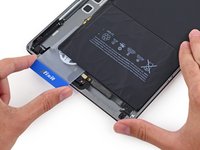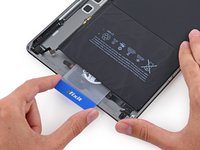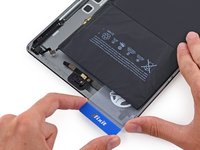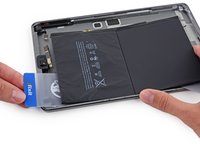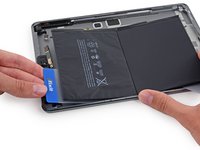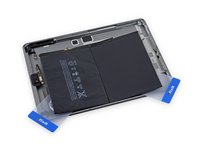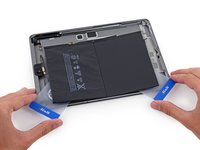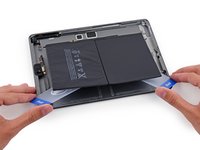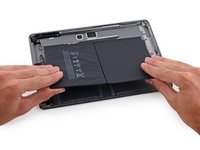Introduction
Suivez ce tutoriel pour retirer et changer votre batterie iPad 6 Wi-Fi.
Si votre batterie iPad 6 Wi-Fi est gonflée, prenez les précautions nécessaires.
Soyez très prudent lorsque vous isolez la batterie en utilisant un médiator pour isoler la batterie. Les contacts de la batterie se cassent facilement, ce qui entraîne des dommages irréversibles sur la carte mère. Si vous choisissez de réaliser cette réparation sans isoler la batterie, évitez d'utiliser des outils métalliques, sauf en cas de nécessité absolue (comme pour retirer des vis), afin d'éviter de court-circuiter la batterie et d'endommager les composants électroniques sensibles.
Ce dont vous avez besoin
-
-
Faites chauffez un iOpener et posez-le sur le bord gauche de l'appareil pendant deux minutes.
-
-
-
Pendant que vous attendez que l'adhésif se ramollisse, notez les zones suivantes qui sont sensibles aux manipulations :
-
Caméra frontale
-
Antennes
-
Nappes d'écran
-
-
Outil utilisé dans cette étape :Clampy - Anti-Clamp$24.95
-
Tirez la poignée bleue vers l'arrière pour débloquer les bras de l'Anti-Clamp.
-
Posez votre iPad sur un objet, afin qu'il soit au même niveau que les ventouses.
-
Positionnez les ventouses au milieu du côté gauche de l'iPad – une dessus, une dessous.
-
Tenez fermement le bas de l'Anti-Clamp et appuyez sur la ventouse supérieure pour que les deux adhèrent.
-
-
-
Tirez la poignée bleue vers l'avant pour bloquer les bras.
-
Tournez la poignée dans le sens des aiguilles d'une montre, de 360 degrés ou jusqu'à ce que les ventouses commencent à s'étirer.
-
Vérifiez que les ventouses restent bien alignées entre elles. Si elles commencent à se décaler, détachez-les pour les réaligner.
-
-
-
Attendez une minute pour que l'adhésif ait le temps de se détendre et d'ouvrir un espace.
-
Si votre écran iPad n'est plus assez chaud, vous pouvez réchauffer le bord gauche avec un sèche-cheveux.
-
Insérez un médiator sous la vitre tactile lorsque l'Anti-Clamp a créé un espace suffisamment grand.
-
Sautez l'étape suivante.
-
-
-
Une fois que l'écran est chaud au toucher, posez une ventouse sur le bord gauche de l'écran et aussi près que possible du bord.
-
Soulevez l'écran à l'aide de la ventouse pour créer un petit espace entre la vitre tactile et le châssis.
-
Insérez un médiator dans l'espace entre la vitre tactile et le châssis.
I had a screen that was lightly cracked, and when I pulled up on the glass it cracked even further and made a mess of my removal. So, I would recommend taping cracks even if you can get suction so that you don’t induce even more cracks.
I actually had a really badly cracked digitizer. Using the suction cup did nothing but shatter the digitizer more. I intentionally drove a flat head screw driver into the digitizer to reveal the recess in the body where they are showing the opening-pick. Working around the edge, the glass shattered. You still need to be careful at all of spots noted in step 2.
Do not go under the digitizer more than the 1 mm along the sides or 3-4 mm at the corners as shown in step 29 using the flat grey ring around the edge for a reference. Direct all of your tool force into the body to prevent slipping into critical parts.
The antennas at either side of the home button were the trickiest part as they were thin and slightly attached to the digitizer. I would recommend using a plastic tool for these parts if you are having to 'scrape' the glass off of the tabs of the antenna.
-
-
-
Insérez un second médiator dans l'espace que vous venez de créer.
-
Faites glisser le médiator vers le coin inférieur gauche de l'appareil pour séparer l'adhésif.
-
Laissez le médiator dans le coin inférieur gauche pour éviter que l'adhésif n'adhère de nouveau.
-
-
-
Faites chauffer un iOpener et posez-le sur le bord supérieur de l'appareil pendant deux minutes.
-
-
-
Faites tourner le médiator autour du coin supérieur gauche de l'appareil pour séparer l'adhésif.
-
-
-
Faites glisser le médiator le long du bord supérieur de l'appareil, en vous arrêtant juste avant d'atteindre la caméra frontale.
-
-
-
Faites chauffer un iOpener et posez-le sur le bord droit de l'appareil pendant deux minutes.
-
-
-
Faites tourner le médiator autour du coin supérieur droit de l'appareil pour séparer l'adhésif.
-
-
-
Insérez un nouveau médiator et faites-le glisser jusqu'au milieu du bord droit de l'iPad.
There are sensitive display/digitizer cables no less than five inches from the bottom edge of the iPad. Insert the pick further down than this, or deeper than 1mm beyond this point and you risk irreparably damaging these cables.
Three inches is much too far down this side of the iPad to use picks.
-
-
-
Faites chauffer un iOpener et posez-le sur le bord inférieur de l'appareil pendant deux minutes.
-
-
-
Faites glisser le médiator inférieur gauche vers le coin inférieur gauche pour séparer l'adhésif.
-
Laissez le médiator dans le coin inférieur gauche avant de passer à l'étape suivante.
-
-
-
Insérez un nouveau médiator dans l'espace que vous venez de créer sur le bord inférieur de l'iPad.
-
Faites glisser le médiator sur l'antenne, en vous arrêtant juste avant le bouton home.
-
Laissez le médiator à gauche du bouton home avant de continuer.
-
-
-
Faites chauffer un iOpener et posez-le sur le bord droit de l'appareil pendant deux minutes.
-
-
-
Tout en soutenant la vitre tactile, glissez un médiator entre les deux nappes de l'écran pour séparer la dernière partie de l'adhésif.
-
-
-
Une fois que toute la colle a été séparée, ouvrez la vitre tactile comme un livre et posez-la à côté de l'iPad.
While reassembling, REALLY make sure the display cables and the home button cable won't be folded / bent while closing the digitizer. I'm not exactly sure what I did, but I broke the home button and touch ID since I bent the home button cable to the point that it broke. These ribbon cables are SUPER fragile.
-
-
-
Retirez les trois vis cruciformes #00 de 4,3 mm qui fixent l'écran LCD.
Both of the iPad 6th gen models i have seen so for (note they were cellular also) had the LCD secured with a grey silicone kind of adhesive in each corner under the screws. So you can’t just lift the LCD as you normally would after removing screws, it would break. I found you could pick at the corner closest to the rear camera easiest, slightly lift that corner and gently separate the other side next to the headphone jack. Then while supporting the LCD , lever the other end free with a up-and-down motion making slight progress each time.
On my iPad 6, there were small rubber tabs covering the two screws on the front camera side. I carefully held them out of place with tweezers while unscrewing the screws.
-
-
-
Utilisez la partie plate d'une spatule (spudger) pour soulever l'écran LCD hors de son emplacement juste assez pour que vous puissiez le saisir avec vos doigts. Il peut y avoir de la colle autour des trous de vis, qu'il faudra couper avec un couteau.
-
Retournez l'écran LCD comme la page d'un livre, en le soulevant au niveau de la caméra, puis en le faisant pivoter autour de l'axe du côté bouton home de la coque arrière.
-
Posez l'écran LCD sur sa face avant pour avoir accès à ses nappes.
When you replace the LCD be sure to make sure it is screwed in fully. It is easy not, especially on the cornet where the digitizer cables are. The LCD is very sensitive and if you bend it then it can stop working. I was just pressing the digitized in place at the end of a repair and the screen was covered in white lines.
I have no idea of what the logic board looks like !!!
-
-
-
Retirez la vis cruciforme #000 de 2,3 mm qui fixe le connecteur de la batterie à la carte mère.
-
Faites glisser le médiator pour isoler la batterie sous le connecteur de la batterie de la carte mère, en l’inclinant à un angle de 35 degrés.
-
Laissez-le en place pendant que vous continuez votre réparation iPad.
If you insert a regular pick without a gap then you can damage this connector and will need a new motherboard. If in doubt just insert into the left corner enough to raise it a tiny bit. Arguably, if you are not sure, then it is safer just power off and don’t power back on until everything is fully connected. A photo of how this connector looks with its cover off would really help for people that have not seen this type of battery connector before. You just need to get it to lift a tiny bit, Do not try to slide anything under the contacts….
I bumped this darn thing several times, it was twisted and skewed making me freak out but the iPad still works. I am thinking you should pull it out and put the screw back in right after the LCD is removed. Then use it again just before putting the LCD screen back in. The pick is sticking out there waitng to be be bumped.
Hi Robin,
Unfortunately, there is no easy way to pull the battery connector out of the logic board. If you try to pry this connector off, you will irreparably damage it. The easiest solution is to insert the battery blocker in-between to cut the power.
The battery isolation pick or battery blocker is an outdated way of isolating the battery, as you risk damaging the battery pins underneath the logic board.
So what is the new method?
This is my question as well. Seems like this phrase contradicts the instructions. Confusing. Any reply?
We are currently working on a better isolation procedure! In the meantime, I’ve updated the warning to hopefully clarify the issue.
Why do you need to “To reduce the risk of a short”? There does not seem to by any risk of a “short” in this process. I can see other reasons for disconnecting the battery. I am an electrical engineer so I would appreciate a professional grade answer to this question.
I’ll give it a shot!
When you remove the screw, it doesn’t disconnect the battery, as the connector uses spring contacts to touch the battery pads.
If you leave the battery connected, it leaves the logic board energized. As there are many exposed traces and SMT components on the logic board, there is a chance that you accidentally bridge a trace with a metal tool, resulting damage. In addition, the display connector contains tiny pins, and the pinout is such that if you pry the connector from an energized logic board, there is a chance that a voltage rail pin may accidentally touch something it shouldn’t, blowing out the backlight circuitry.
My battery was dead when i did the repair. Did not really need to perform this step
Take a waterproof playing card, cut out the shape of the battery blocker and slide that under. Battery blocked and pins not at risk of damage. Got that from a YouTube video made by a microsolder repair tech fixing the damage caused by jamming a blocker in between the contacts.
Thanks for the tip Melody! I’ve updated the instructions to include the playing card method.
I could not for the life of me get the playing card in there, but my iPad was turned off, so I decided to ‘risk’ a short, instead of potentially damaging the battery connectors by jamming the card in there as hard as possible. My repair went fine, no short, however I realized AFTER closing everything up that I forgot to put the battery screw back in. Really hoping this doesn’t become an issue long term, because I don’t want to pry this brand new screen off just to put the battery in.
Let us know! I wasn't able to use the screw again after removing the battery blocker. Now my iPad turns off and on every so many minutes and when it restarts it's 1% and then shows actual charge.
When you come to screw this back together, do not overestimate how little force it takes to strip the thread on this #000 screw. I did, and I now I can't screw this back down and have the problem where the iPad restarts every 3 mins 20 sec after you turn it on due to a poor connection here. I've used card to pack this out so the LCD puts a little clamping force on the terminal once you screw it back in, but it's not really enough so the iPad still suddenly restarts occasionally.
I use a small screwdriver and pry underneath that brown bracket from the top edge by the camera (with the elongated metal cover removed of course) all the way before the battery, then lift up just enough for me to unhinged the battery out of the secure post. I don't know why Apple has to go through ALL THIS just to connect the battery since there is a small screw AND ADHESIVE securing it anyway. Nonetheless the whole job (replacing the lcd screen and battery was a major pain in the neck!
-
-
-
Retirez les trois vis cruciformes #000 de 1,4 mm du cache de la nappe de l'écran.
I believe these are also Phillips #00, not Phillips #000.
I lost a 1.4mm screw where can I buy these small screws and how big are they? 1.4mm x? flared or flat head
-
-
-
Enlevez l'adhésif qui recouvre le connecteur de la nappe du bouton home.
-
-
-
-
Utilisez le bout plat d'une spatule (spudger) pour lever le connecteur ZIF de la nappe du bouton home.
-
Retirez avec précaution la nappe du bouton home du connecteur ZIF.
I'm confused about the home flex cable connector required for the 6th generation iPad. It was my understanding that this model required an 18 pin connector. But these excellent pictures clearly show a 14 pin connector, just like the one for the first generation iPad Air AKA the iPad 5. I know this is not the primary focus of this guide, but can anyone clarify this for me?
I did the whole repair but this part is the problem HELP !!! I unlocked it but it took me 1 hour to carefully pull out the HOME BUTTON RIBBON CABLE. It finally came out with tweezers but now I CAN'T GET IT BACK IN and as a result my touch I.D. won't activate. It seems there was a tiny bit of black tape overlapping the connector on the ribbon which I carefully cut off exposing only the connector on the ribbon itself but how the heck does it slide in before you lock it. It seems easy on Youtube videos but mine just doesn't slide in with hand or with tweezers. OR in fact is there another connector that controls the TOUCH I.D. ???
Failed this step- broke the connector. If I try this again, I'd be inclined try to remove the home button from the front panel without unplugging it. Everything else seems to work fine.
I too failed this step. Needed some up close pics of how this works. Now what do I do the connector on the board is broken?
-
-
-
Utilisez le bout plat de votre spatule ou bien votre ongle pour détacher avec précaution les connecteurs des deux nappes de la vitre tactile de leurs prises.
Where can I get a good used motherboard for a A1954 iPad 6 gen everywhere I look, there sold out ?...
-
-
-
Retirez avec précaution la nappe du bouton home de l'adhésif qui la fixe à la coque arrière.
If you can make sure to not pull on the home button side, i would leave out this step. i replaced two displays so far, on the first i removed it, but left it connected on the second attempt. worked like a charm
-
-
-
Enlevez le panneau frontal.
-
Si vous rencontrez des soucis d'appuis "fantômes" sur l'écran, ceci peut être résolu en ajoutant une fine couche de ruban adhésif isolant, comme de la bande polymide, sur les parties en rouge derrière du panneau. Les pièces iFixit sont initialement équipés d'une bande protectrice et ne requièrent pas de couche d'adhésif supplémentaire.
-
-
-
Insérez une spatule (spudger) sous le câble d'antenne le plus proche du bord de l'iPad et soulevez-le vers le haut pour débrancher le connecteur du câble d'antenne.
Skip to the step 98 or even 100 if you just need to replace the power button - I think you should even consider this to replace volume buttons. I am fixing mine right now and screwed up the speaker cable. I did follow the instruction but totally missed the cable right below the tape. I proceeded further, but I just realized I didn't have to go through all the troubles. I wish ifixit.com can manage this type of direction clearly so that dis-assembly is minimum.
After you replace the Digitizer if you are getting random key presses it is likely to be because Kapton tape has not been applied to the edges of the digitizer. You need to cover the silver strip around the edge of the digitizer with kapton tape before reassembling. Works every time.
This is my first ipad and when the battery dies, it will be my last, way overrated and no options like memory cards or mini usb ports, and the battery thing is ridiculous,I wish I would have never bought this knowing this stuff , and way over priced.
It always helps to Google something before buying it. "iPad Air reviews" in Google would have saved you. I just find it funny how in this day and age, people STILL make "purchase mistakes" because they didn't take the time to research the several-hundred-dollar device they are about to commit to purchasing. You should have seen the amounts of research I did before buying my $1,399 Asus G751JY laptop. I'm absolutely pleased with it and am happy I don't deal with issues other people have. Just be weary, buddy. ALWAYS GOOGLE.
Scott S -
If you just want to replace the battery, skip to step 99. You can easily get to most sides of the battery without removing all other components. It worked for me. Good luck!
I wish I read this comment. Would have saved me a lot of time.
leo -
I followed your piece of advice and went to step 99. My new battery works just fine without removing all those components including the logic board - thanks a lot!!
An important note - as per the comments lower down, you can skip ahead to step 95 (unsticking the battery) just fine if you're just changing the battery, but after you've unstuck the battery you will need to go back to step 88 and soften the logic board adhesive so you can pry it up about a cm and lift the battery terminal up and over the post to remove it. I didn't realise the post was there, and broke off a piece of the original battery terminal that got stuck under the logic board. This prevented a good connection with the new battery, and caused random restarts after I put everything back together until I realised and went back to recover it.
Don’t skip to 99 because you need to remove the logic board.
I have successfully replaced the Battery without removing any components other than the Screen Assembly and LCD. You can skip steps 44 thru 99 by using a spudger as a wedge to lift & hold the Logic Board high enough to lift the battery contact over the post that holds it in place… this will save you a lot of time and frustration and makes the repair sooo much easier.
My goal was to replace the battery. As some suggested I skipped some steps. I did Step 46 and left out 47 to 100. But I think Step 46 can be skipped too. iFixit probably does not recommend skipping these steps because it is riskier to bend the batteries and damage them. But if you work carefully enough and make sure the adhesive has been softened well, you should be fine. It was no problem for me. It saved me quite some time. (I will write a comment in Step 102 to help you get the batteries out without Steps 46-100.)
-
-
-
Deux gros morceaux de bande adhésives sont enroulés autour du câble d'antenne droit, le fixant à la coque arrière.
-
Décollez l'adhésif de la coque arrière.
You may partially skip steps 46 to 100, as it is not really mandatory to remove all those parts in order to remove the logic board and the battery.
-
-
-
Insérez avec précaution un médiator entre l'enceinte du haut-parleur et le support du câble d'antenne.
-
Faites glisser le médiator vers le bouton home pour couper l'adhésif.
-
Poussez la fixation loin du haut-parleur jusqu'à ce qu'elle laisse apparaître la bande adhésive en dessous.
The pick was not thin enough but the razor worked.
In my view there is a few destructive steps here. I have been able to remove this entire assembly by lifting only the adhesive tape anchoring it to the back without touching this fine metal bracket as touched in in Step 46 & 63 or tearing the foam in Steps 48 & 65 on both the left & right sides. Remove the screws as in Step 47 & 57 and the one’s either side of the charging port in 64 & 71. Once removed, the only thing securing these to the rear is adhesive tape. Lift the tape and walk the units out by nudging them from side to side.
Thanks. Made the whole next chunk much simpler :)
-
-
-
Retirez les vis cruciformes #000 suivantes, fixant l'antenne droite :
-
Une vis de 2,3 mm
-
Deux vis de 1,4 mm
I would strongly advise not to follow this step and following ones: removing the 2 Wi-Fi antennas is not required for complete disassembly of the motherboard and battery, and you may potentially destroy your antennas: I scrupulously and foolishly followed this tutorial step by step and now I have severe Wi-Fi problems on my iPad because one of the 2 antennas has been damaged during the process (and by reading all the comments on this page you'll see that I'm not the only one to have this issue...).
=> As someone else already mentioned it in the comments, just skip most of these steps and go directly to something like step 79.
-
-
-
Insérez l'extrémité plate d'une spatule entre l'antenne et l'ensemble de haut-parleur.
-
Faites glisser la spatule vers le bouton home pour couper l'adhésif en mousse qui fixe l'antenne.
Este paso es innecesario, ya que con solo quitar los tornillos es suficiente, no hace falta despegar la goma espuma que mantiene la antena de la bocina.
tout a fais il n'est pas nécessaire de décoller l'antenne du haut-parleur ! Il faut juste enlever les vis et continuer le démontage du haut-parleur en laissent l'antenne fixer a lui !!!
Faire de même pour le deuxième haut-parleur !
-
-
-
Insérez une spatule sous le câble d'antenne gauche et soulevez-la vers le haut pour débrancher le connecteur du câble d'antenne.
-
-
-
Cinq morceaux de bande adhésive sont enroulés autour du câble d'antenne gauche qui recouvre le connecteur de la nappe du haut-parleur droit.
-
Décollez ces bandes de la coque arrière.
-
Repliez le câble d'antenne de côté pour qu'il ne vous dérange pas.
This step was not very well explained. It fails to mention the speaker cable attached on to the tape. This caused the speaker cable to be torn since it is so thoroughly attached to the tape. Guide made no mention that it was under there or that you should be careful about it. Not even the usual remove the tape gently they just tell you to rip it right off no problem. Not sure how this was missed when the guide was so thorough about this beforehand.
Approx. 3/4 of an inch past the bend in the cabling underneath the tape lies the right speaker cable. Beyond this point proceed with extreme caution. Delicate cables and ZIF connectors underneath the tape will be torn or damaged if they aren't separated from the underside of the insulation tape first. Use fingernails or thin-edged tools.
An update to this would be nice. Will the Ipad work with a broken spaker cable? Is it possible to get replacement part? Maybe this step should be rewritten.
-
-
-
Insérez un ongle ou l'extrémité plate d'une spatule dans la rainure dans le boîtier du haut-parleur, près du coin de la coque arrière.
-
Tirez le haut-parleur vers le bas, loin du coin de la coque.
-
-
-
Utilisez une spatule pour aider à tirer le haut-parleur de sous le rebord de la coque arrière.
-
Retirez le haut-parleur droit de l'iPad.
When did you remove the blocker after installing the battery blocker? No photos with blockers after this procedure.
-
-
-
Retirez les trois vis cruciformes #000 de 1,4 mm fixant le cache de la nappe des composants supérieurs.
-
-
-
Il reste deux morceaux de bande adhésive fixant le câble d'antenne gauche à la coque arrière.
-
Décollez la bande adhésive de la coque arrière.
-
-
-
Insérez avec précaution un médiator entre l'enceinte du haut-parleur et la fixation du câble d'antenne.
-
Faites glisser le médiator vers le bouton home pour couper l'adhésif.
-
Poussez le médiator loin du haut-parleur jusqu'à ce qu'il soit dégagé de la bande adhésive qui se trouve en dessous.
-
-
-
Retirez les vis cruciformes #000 suivantes :
-
Deux vis de 1,4 mm
-
Une vis de 2,3 mm
I didn’t need to take the left antenna and speaker out. If you just get the wire and tape out of the way so you can unplug the speaker flex cables and take out the lightning connector, then you should still be able to get the logic board out. the left speaker isn’t in the way at all.
-
-
-
Insérez l'extrémité plate d'une spatule entre l'antenne et l'ensemble de haut-parleur.
-
Faites glisser la spatule vers le bouton home pour couper l'adhésif en mousse qui fixe l'antenne.
Este paso es innecesario, ya que con solo quitar los tornillos es suficiente, no hace falta despegar la goma espuma que mantiene la antena de la bocina
-
-
-
Utilisez l'extrémité plate d'une spatule pour débrancher de la carte mère le connecteur de la prise jack.
-
Écartez la nappe de la prise jack pour qu'elle ne vous dérange pas.
Note for others. On this connector, i have some tape keeping it down, it's rather difficult to remove without ripping it. So i ripped the tape to remove it.
"Ripping" the tape seems ill-advised. A sharp ceramic craft paper cutting knife or the very tip of a fine-tip Exacto blade work well. Once the tape is cut on one side, the blade slides through it like it's nothing. Zero force required.
Be careful not to insert a blade too far or it may come into contact with conductive components.
-
-
-
Retirez les deux vis cruciformes #000 de 3,3 mm fixant le port Lightning.
NOTE for others who might miss this: this picture is looking down, out the bottom of the iPad. There are four other screws near the lightning port, two for the speakers and two for the port. You see these four easily, looking down at the battery and motherboard. These two are additional to those, and perpendicular to them. Both pairs of lightning port screws, one set perpendicular to the other, must be removed.
Where did the battery blocker go? It was introduced in step 35. Nowhere has it been said it can be removed . . . yet it is now absent in this picture. I took it out when I got to steps 93-96.
Yes this is a deceptive image as the battery and connector strap seem to be missing. Hold your iPad vertically and look down at the lightning port and you’ll see these hidden screws.
Thanks for your comment! I’ll add a note in the step.
-
-
-
L'adhésif se présente sous la forme de six morceaux de mousse adhésive noire – reportez-vous à cette étape pendant que vous vous occupez de réchauffer et décoller, pour savoir où se trouve chaque morceau.
Thread a piece of dental floss under the tip of the logic board. Be careful when rounding the corner not to snag any ribbon cables. This easily released the foam tape up to the battery connector.
Les 2 images suivantes sont contradictoires. elles donnent l'impression de devoir enlever la carte mère.
@totoy Effectivement, cela peut-être perturbant, mais ces images servent de référence et expliquent où se trouvent les six morceaux d'adhésif qu'il va falloir décoller au cours des étapes suivantes pour retirer la carte mère.
-
-
-
Enfin, faites glisser le médiator entre la batterie et le connecteur Lightning lui-même pour décoller ce dernier de l'adhésif sous la nappe.
There are two screws holding the lightning connector to the rear case, I didn’t see them in this guide. I recommend removing them before you attempt to remove the lightning connector, otherwise you’ll look like an idiot struggling with it for around 1/2 an hour like I just did.
Did you skip this step?
I had this problem too!!
Will Young is correct. The two extra screws are horizontal - they are in addition to the vertical screws mentioned in step 82.
@usablethought AFAIK there are only two screws securing the actual port to the chassis. You can tell by looking at the part—there are only two screw holes. Those additional screws can be left in place, as shown in the photos. At least, that was my experience. If you’re working on a different model, then of course you may need to improvise—the instructions are only for the model indicated.
-
-
-
Tirez le connecteur Lightning tout droit hors de sa prise dans la coque arrière.
there were two screws holding the lightening connector in place on my iPad
Yep! In this guide those screws are removed in Step 82, but you can remove them at any point prior to taking out the Lightning connector.
CAUTION - there are two ‘hidden’ screws holding the lightning port that face the battery. Hold the iPad vertically and look down to see them. I almost broke the cable trying to remove it thinking it was just stubborn adhesive. Yes its mentioned at Step 82 but its a confusing illustration and easily overlooked.
-
-
-
Insérez un outil d'ouverture en plastique dans l'espace rectangulaire en haut de la carte mère et faites levier sur la carte mère depuis la coque arrière.
-
Tout en maintenant l'outil d'ouverture sous la carte mère, faites-le glisser sur la longueur de l'espace pour décoller l'extrémité supérieure de la carte mère.
-
-
-
Faites glisser le médiator sur toute la longueur de la carte mère.
-
Une fois que l'adhésif a été coupé, faites levier du côté de la batterie et soulevez la carte mère vers le haut, hors de la coque arrière.
Don't touch the small components which are under the motherboard !!! If you do it your iPad is definitively dead.
-
-
-
Retirez la carte mère de l'iPad.
Nice guide, thank you, very helpful. There would be no way to guess where the glue stripes are located and a couple of connectors are very difficult to spot. I don't see any need to remove the antennas and the speakers though, they are not really an obstacle to remove the board and can be left in place. The lightning connector is secured in place by two other two horizontal screws which are not shown in the guide.
Thanks again !
Technically, you are correct. But those screws are holding a bracket-like piece for the lightning connecter to screw into- which if you think about it, it wouldn't be considered apart of the lightning port (or at least that's what i think). Not trying to start an argument, as this comment is old, but yeah.
Kaz -
This is a bear of a job, and I wouldn’t have had any hope of completing it without this guide. THANK YOU for all your hard work!!!!
-
-
Outil utilisé dans cette étape :iFixit Adhesive Remover$19.99
-
Réchauffez l'iOpener au micro-ondes pendant 30 secondes.
-
Placez l'iOpener chauffé au centre de l'arrière de l'iPad. Laissez-le agir pendant 90 secondes pour ramollir l'adhésif de la batterie.
-
Déplacez l'iOpener vers la droite (loin de la caméra arrière) et laissez-le agir pendant 90 secondes supplémentaires.
-
Enfin, déplacez l'iOpener sur le bord droit de l'iPad pendant 90 secondes.
-
-
Outil utilisé dans cette étape :Plastic Cards$2.99
-
Insérez une carte en plastique sous la batterie inférieure, dans le coin en bas à droite.
Did you skip Step 46 through 100, then this is for you: Because the logic board is still in, you will have less space to loosen the battery pack. Be extra careful not to bend it. Work from the sides that are more accessible like in Step 113 and slowly work your way underneath the battery pack to loosen it all over. As I was loosening the battery I had the heated iOpener underneath the part I was working on. This really helped a lot. And be patient. You do not want to force it.
First of all, thanks @marcelflueeler and everyone else who gave advice on skipping ahead. This is definitely the way to go if you're just changing a battery! Once you've unstuck the battery you'll find you can't pull it out because it's stuck at the terminal though. Don't try and force it here! You'll need to return to step 88 and soften the logic board adhesive so you can pry it up about a cm, then you can lift the battery terminal up and over the locking post that's holding it in place. I didn't realise this and broke a piece of plastic off the old battery terminal, which got lodged under the logic board and prevented a good battery contact until I realised and retrieved it.
-
-
-
Saisissez fermement les deux cartes et tournez-les pour soulever la batterie hors de la coque arrière.
-
Retirez la batterie de la coque arrière.
Finally done !
It took me nearly 3hrs, but i finally made it. Thanks for the great instructions
REASSEMBLY TIPS:
The adhesive strips that come with the iFixit battery have no labels to say which goes where. Look at them carefully and one side has a blue protective cover that runs the length of each strip. This faces up and is to be removed at the last moment when you’re ready to stick the screen down permanently. One strip has a narrowed section in the long length to clear the glass touch screen cables, so stick this one down first to avoid mistakes.
Before removing the protective strips, close the touch screen and boot the iPad. Test both cameras, wifi and speakers. (I found the rear facing camera connector hadn’t bedded properly which was easily fixed). Clean the screen and remove dust from LCD before bedding in touch screen.
The iFixit site has updated battery calibration instructions which differ from the card packed with the battery:
Charge it to 100% and keep charging it for at least 2 more hours.
Then use your device until it shuts off due to low battery.
Finally, charge it uninterrupted to 100%.
Great tip to boot the iPad before removing the adhesive from the battery. There are quite a few comments here about faulty batteries. Fortunately, mine worked just fine.
The iFixit battery replacement kit worked great! The repair guide is very good also. So glad I didn’t just try buying the battery. While testing everything after finishing the battery replacement, the digitizer, volume controls and the sleep button did not work. I was very happy when I went back in and found the cable connections had just come loose. My wife couldn’t believe I fixed her iPad.
The guide was pretty good but a few comments:
I didn’t liked the iOpener that much. I used an heat gun with good temperature control instead.
Any advice on how to remove the old glue residu would have been welcome. I used a combination of physical scraping and cleaning afterward with isopropyl alcohol.
An extra guide on how to apply the new adhesive strips would also be nice.
Fixed!....The guide is very clear and well laid out. I also had issues with the iOpener not working, I needed more heat, used heat gun with temp control. Also used floss to remove the logic board. Would have appreciated more clearer instructions on adding the adhesive strips.....Thanks
The iOpener is really bad. It isnt hot enough to keep the iPad that cools down to roomtemperature in a few seconds. I used an hair dryer which was also not warm enough but at least made it warm enough to create a gap where I was able to fit my pics under. Unfortunately my Digitizer still died. Battery works but I cannot turn off my iPad now lol
Very good guide to a very tedious project! Thank you for the detailed description of the digitizer separation. I didn’t sever any cables. The iOpener isn’t bad; it’s just too small. This project really requires the Anti-clamp, the acetone/isopropanol adhesive softener, and a heat gun that can be used at a low heat setting. I didn’t try a hair dryer, but I think that it might be too windy. Like other fixers,I skipped steps 47 thru 100 something and took my chances manhandling the battery. I opted to insulate the digitizer with Kapton tape. I only have a wide roll of Kapton, so I stuck it to the stiff plastic backing for the battery, then cut narrow strips and peeled them off the backing. Finally, I’d like to see a show of hands of the people who forgot to put in the four corner screws for the display. Maybe I’m the only one …
I successfully replaced the battery in my A1954. But I stopped at step 40 and then I just pried the old battery with the plastic cards that came with the new battery and some isopropyl alcohol. Next step I pried the logic board upwards with a blue pick around the screw area. The board needs to flex upwards more than you're comfortable with in order to make room for the new battery connector to slide underneath the pick but over the screw hole underneath the logic board. I dint't really feel like gutting the entire housing of all the parts but I was risking damaging both the logic board and the new battery. So do it at your own risk.
-
Pour remonter votre appareil, suivez ces instructions en sens inverse.
Pour remonter votre appareil, suivez ces instructions en sens inverse.
Annulation : je n'ai pas terminé ce tutoriel.
46 autres ont terminé cette réparation.
Merci à ces traducteurs :
100%
Claire Miesch nous aide à réparer le monde ! Vous voulez contribuer ?
Commencez à traduire ›
12 commentaires
analyzing the structure of the arrangement of the components, is it necessary to remove everything? I think you could only remove the battery without removing the logic card.
Hi Vik,
While it may not be necessary to remove the logic board to remove the battery, we found that it is the safest option. Removing the logic board first allows you to pry the battery around all the edges while keeping the bending to a minimum.
Thanks for a great guide! I left out steps 47 to 100 as some suggested and it worked fine for just replacing the battery. I was aware that the issue may be the bending of the battery and, therefore, iFixit does not recommend skipping these steps. However it worked fine for me. My tip is to allow yourself enough time to loosen the battery from the adhesive and keep the heated iOpener always underneath the section of the battery that you are working on. This way the adhesive softens and allows you to loosen the battery step by step. - It took me 3 hours of which the first hour was trying to figure out how to get Step 9 done. It took me a while to have the iOpener at the right temperature. So, be patient.
The guide worked perfectly, thanks! But now there is an issue with the battery after reassembling. The iPad can‘t be charged and it turns itself off every 5min.
Any ideas?
Unfortunately I have the same issue, did you fix this after all?
I M -
I attempted this but didn’t work for me. Lots of precision and macro vision work. Tablet is very easy to damage the ribbon cables. Had to replace “rear camera” and “Finger Print Button”. Still had issues. Next step was to replace The Digitizer which I didn’t do. Ended up buying a new iPad9.
If you're display is cracked replace the battery while you're at it.
If it's in one part don't try this, you're digitizer won't come out in one piece.
For those with battery issues / shut downs after replacing , most likely the small spring clips on the logic board that make contact with the battery terminals have been damaged due to incorrect placement of the battery isolation card / or method used. If these clips are damaged you will need to replace the socket itself on the logic board which requires a solid skill set and correct tools to perform.
Had display issues due to intermittent display connector in a never opened iPad. Thought I would replace the battery while I was in there, so I ordered one when I ordered the adhesive strips. I've been working on electronics since I was 12 years old and I am 70 now, so 58 years. When I looked up this excellent guide I concluded that the risk/reward ratio of replacing a worn but functional battery on this old iPad just is not in my favor. I'll let Apple win for now. If the battery fails, then I'll go back in, but this is Apple's obstructive engineering at its best.
SECOND THOUGHTS: Just watched the iFixit video on Youtube. Maybe it isn't as bad as I thought. Got to go order some adhesive remover though. Wish me luck.




















































































































































